
 US Maritime Commission 1940-45: 238 Built
US Maritime Commission 1940-45: 238 Built
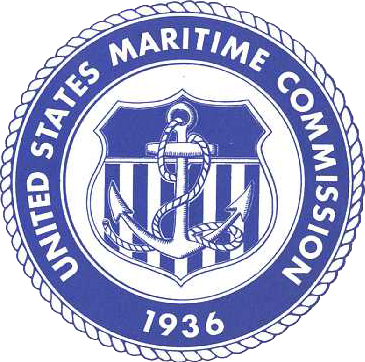 Foreworld: US Maritime Commission Fleet
Foreworld: US Maritime Commission Fleet
The United States Maritime Commission (MARCOM) was an independent executive agency of the U.S. federal government created by the Merchant Marine Act of 1936, abolished on May 24, 1950. Created at first to replace WWI vintage vessels of the United States Merchant Marine and operate ships under the American flag. It formed the US Maritime Service for training officers and from 1939 until 1945, funded and administered the largest and most successful merchant shipbuilding effort in world's history with 5,777 oceangoing merchant and naval ships total.
♆ Liberty ships - ♆ Victory ships - ♆ Freighters Type C1 - C2 - C3 - C4 - ♆ Tankers T1 - T2 - T3
The C3 Cargo Type: Faster than U-Boats

SS Mormac Isle
The more famous and far more numerous “Liberty Ships” derived for an, early standard cargo defined by MARCOM in 1938 to replaced WW1 vintage standard vessels. Three types were designed, the largest of which became the Type C3-class, third type designed. With preliminary plans largely circulated and communicated to civilian yards for comment. The design presented was adaptable to all trade route and bulk palleted payloads, a large general purpose ship modular enough to be later modified for specific uses. In total 162 C3 ships were built in 1939-1946, but many more hulls (238 in all) were constructed (so 76 more) to be later declined into several variants among which many escort aircraft carriers.
Development design

USS Hercules, the 1940 prototype
The Long Range Shipbuilding Program paired by an ambitious 500-ship goal conducted the U.S. Maritime Commission to turn to standardization and shorting the usual practice of shipping lines designing their own tailored vessels to service said routes. The Commission ambition was to unit all the needs by making an easily adaptable, modern but also safe and well-appointed vessel that would be in addition efficient and fast in order to defeat potential submersibles.
The Commission rated the basic need along three basic designs called “C1,” “C2,” and “C3” denoting increasing capacity and length. They also differed by having different powerful engines, steam turbine for the C3 and and diesels for the C1/2. It was combined with modern cargo equipment, fire-retardant fixtures, and improved crew and passenger living spaces, made the vessels popular with both commercial operators and the U.S. Navy. In fact, many of the navy’s auxiliary ships during World War II were Maritime Commission “C” ships.
The C3 was larger and faster than the C1 and C2 at 492 feet (150 m) overall, versus 459 feet for the C2. More than that, they were designed with a more powerful propulsion in order to make 16.5 knots (30.6 km/h; 19.0 mph) versus 15.5 knots for the C2, and thus, allowing them to out-pace the known surface speed of U-Boats. Later it was downgraded on the Liberty ships (11–11.5 knots). Like the C2 however they were fitted with five cargo holds. The hulls proved even more popular as 465 were built between 1940 and 1947, all in US Yards and then transferred via lend-lease.
The C3 was 492 ft long, 69.5 feet wide, with a 28.5 foot draft. They registered at 7,800 gross tons and 12,000 deadweight tons. Of the 465 built until 1947 and if most were equipped with a turbine rated for 8,500 hp and from 16.5 to 18 knots they wete used by the following lines:
- American Export Lines
- Newport News Shipbuilding & Drydock
- Seas Shipping
- American South African Line
- United States Maritime Service
- Four Aces
- American President Lines
- Moore-McCormack Lines
Hull and facilities

Liberty ship in comparison. I could not find blueprints for the C3 as a cargo
Although there was a base design, many varianst existed (see below). The basic, initial model had a “clipper stern” with some flare, but this was simplified over time. As usual freeboard was high, with a prow capable of dealing with heavy weather, twice as high on its forecastle compared to the amidship’s freeboard. This made them good seaboats, albeit somehwat stiff. They were divided into eight modules and this never changed but after postwar civilian reconstructions:
- Forcastle, crew’s quarters
- Main deck, first hold
- Main deck, second hold
- Main deck, third hold
- Island (main superstructure)
- Main deck, fourth hold*
- Main deck, fifth hold*
- Stern quarters
*Note: Part of the machinery space and fuel tanks were located below the holds and the waterline to mitigate a torpedo blast.
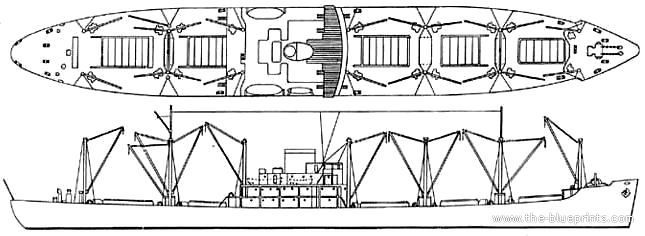
2 plan view, note much the larger island compared to the Liberty ship. She could also carry passengers with extensive facilities.
The holds were served by no less than seven ladder-type poles operating each two cranes or more (four for the ladder masts). The fore and main masts were attached to these ladder porticos fore and aft.
The C3 were powered as said above by a single compact turbines located in the aftermost section, turning a single large propeller with a short shaft. The type of steam turbin use varied among yards, but the Allis-Chalmers type proved the most popular. Fed by two admiralty type double-ended small tubes boilers running on oil, the powerplant delivered 8,500 hp, enough for runs at 18 knots and more when needed, but cruise range was down to 12 knots.
Armament-wise, each ship, albeit having a civilian crew, was complemented by a small Navy personal to operate the armament aboard. This varied greatly among ships, from nothing at all to a heavier armament for those converted. In general however, they were less well armed than Liberty Ships. If armed, they likely had a single 12-in/38 main artillery piece, generally located on the forecastle, four or more single 40 mm/70 and 20 mm/70 Oerlikon AA guns.
C3 Variants

Illustration of a C3-E, private design of the American Export Line, with its Export-Line-stern. Drawing from usmaritimecommission.de
C3: 12,595 tonne: USS Anne Arundel
C3-A: 10,000 tonnes: USS President Polk
C3-E: 9,514 tonnes: USS Hercules
C3-P&C: 10,000 tonnes Some Avenger-class CVE
C3-S-A1: 12,595 tonnes: CVE HMS Tracker, some Bogue-class
C3-S-A2: 12,595 tonnes. USS DuPage
C3-S1-A3: 12,595 tonnes, Funston class APDs
C3-S-A4: 11,000 tonnes, as the six “President” ships
C3-S-A5: 11,800 tonnes: HMS Chaser CVE.
C3-S1-BR1: 9,900 tonnes (3 built: Del Norte, Del Sud & Del Mar)
C3-S-BH1: 12,600 tonnes, 5 built: Tillie Lykes, Almeria Lykes, Lipscomb Lykes, Norman Lykes & Doctor Lykes
C3 Mod.: 12,430 tonnes. Ex. USS Euryale
Proper Navy Variants
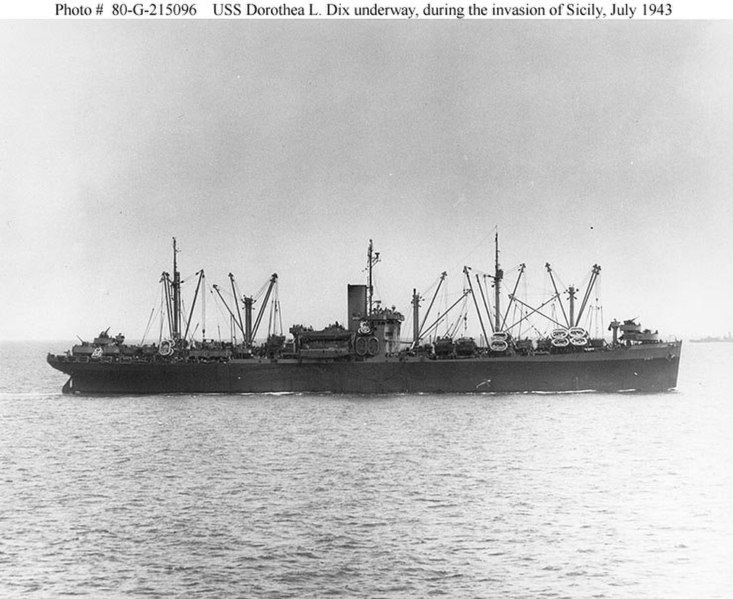
USS Dorothea, Operation Husky, Sicily
The Navy had its fair share of extra hulls to be turned into specialized versions, coming as part of the vast fleet of 465 vessels. The 75 “proper C3” hulls were mostly used as base fo escort carriers;
Long Island/Charger class escort carriers
USS Long island (CVE-1) was like HMS Audacity a quick conversion of the C3 USS Mormacmail, the firsr USN light “auxiliary”, or escort aircraft carrier (CVE), designed in peacetime for the sole purpose of convoy escort in the Atlantic, for the US leg of convoy escort. USS Long Island was the first conversion of that kind, without island and a small hangar. She was superseded by the far better USS Charger (CVE-30) in 1942. The latter is artifically considered in the same class but was in reality very different, including a larger hangar and proper island. She became the prototype for the Bogue class ans almost 75 conversions, mostly destined lend-lease.
Bogue-class escort carriers

USS Bogue in Bermuda, Feb. 1945
Derived from USS Charger (CVE-2), first with an island, the Bogue class were about eleven vessels retained in USN service during the war, based on C3-S-A1 and C3-S-A2 ships. The other eleven went to the Royal Navy as the Attacker class. Laid down in 1941 and converted at that time, they were commissioned from August 1942 to May 1943 and saw active service in the Atlantic, and Pacific from 1945.
They were typically 8,390/13,980 tonnes FL, for 495 ft 8 in (151.08 m) in lenght, 82 ft (25 m) at flight deck level for a maximum draft of 26 ft (7.9 m). Their single Allis-Chalmers turbine connected to two Foster-Wheeler boilers working at 285 psi (1,970 kPa) provided 8,500 shp (6,300 kW) for 18 knots (33 km/h; 21 mph) and the amazing range of 26,300 nmi (48,700 km; 30,300 mi) at 15 knots, based on 2,400 long tons of fuel oil.
As CVEs they were well armed, with two 5 in/51 and ten 20 mm Oerlikon AA guns (it varied over time and type); Air facilities comprised a single hydraulic catapult and two elevators and their hangar housed from 19 to 24 aircraft.
Archer-class escort carriers
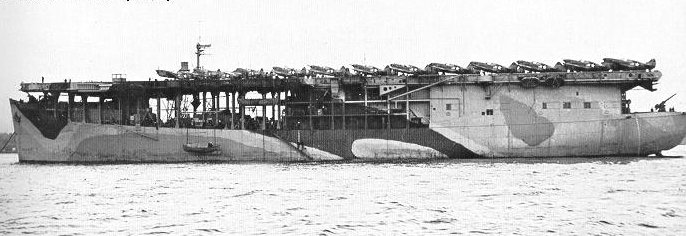
HMS Archer, a clone of Long Island.
After the leasing of HMS Archer, an island-less early CVE, the conversion of Mormacland by the Sun shipbuilding yD. Converted at the Atlantic Basin Iron Works at Brooklyn New York and comm. on 6 May 1942, she was followed by many more carriers based on other C3 cargo versions:
Avenger class: Same design as Archer but new specifications and arrangements: HMS Avenger, HMS Dasher, HMS Bitter (launched 1940)
Attacker class: New design with larger flight deck and hangar for 24 aircraft, elevators and catapults. 11 built and commissioned until June 1943 (same serie as the 11 Bogue).
Aleer class: Or “ruler class”, 23 vessels like the Bogues buot at Seattle-Tacoma Shipbuilding Corporation but built in three specialized groups.
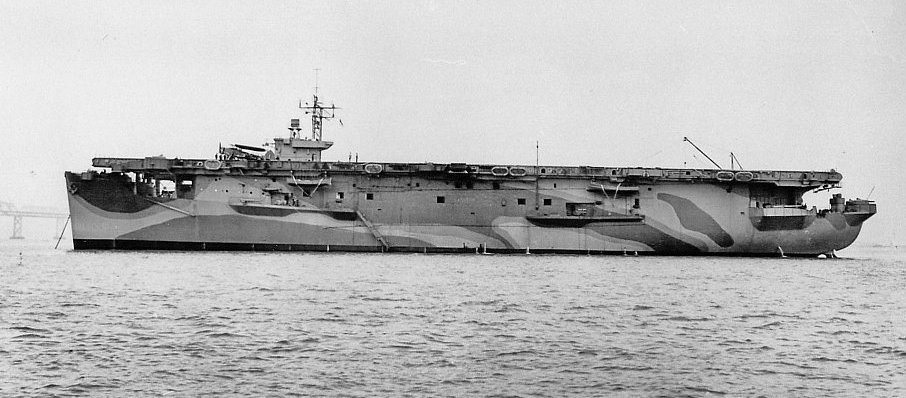
HMS Attacker, lead vessel of its class.
Windsor-class attack transports (APD)
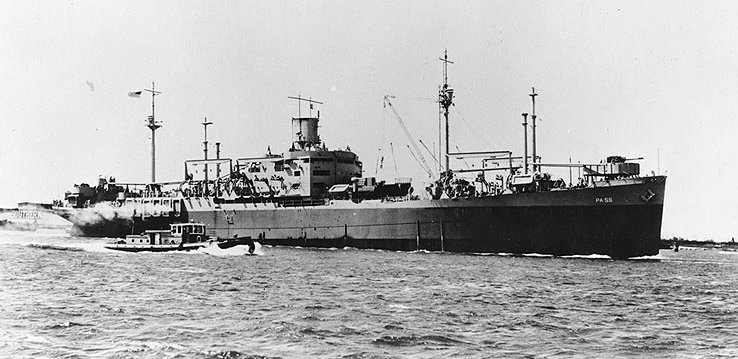
USS Windsor, APA-55
The class comprised 16 vessels total, with for the Windsor, Leedstown, Adair, Dauphin, Duchess, Queens, Shelby and for Funston, O’Hara, Griggs, Grundy, Guiford, Stika, Hamblen, Hampton, Hannover.
The first class nine entered service between 1943 and 1945, and can carry 150,000 cu ft (4,200 m3), 1,600 tons. They had a single 5″/38 caliber gun mount and light 20 mm AA. They only served in the Pacific. USS Windsor and Leedstown earned collectively five battle stars. The Funston served mostly in the Atlantic. Five arrived too late to see any combat but took part in “magic carpet” and also carried occupation troops in Japan, China and Korea and after 1946 they were all sold on the commercial market though many were scrapped in the 1970s.
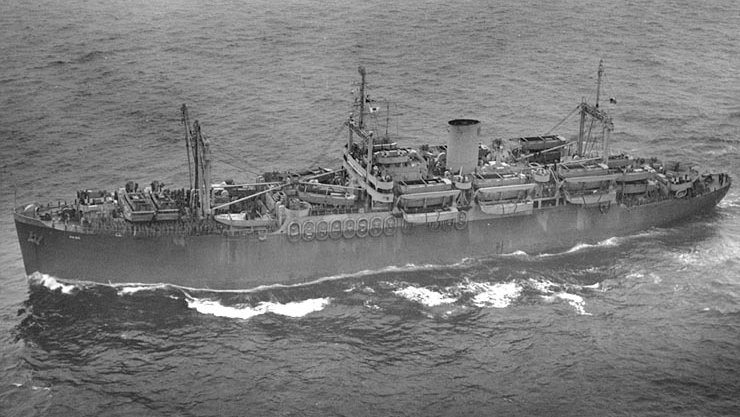
USS James O’Hara, APA-90 in the Atlantic, June 1943.
Bayfield-class attack transports (APD)
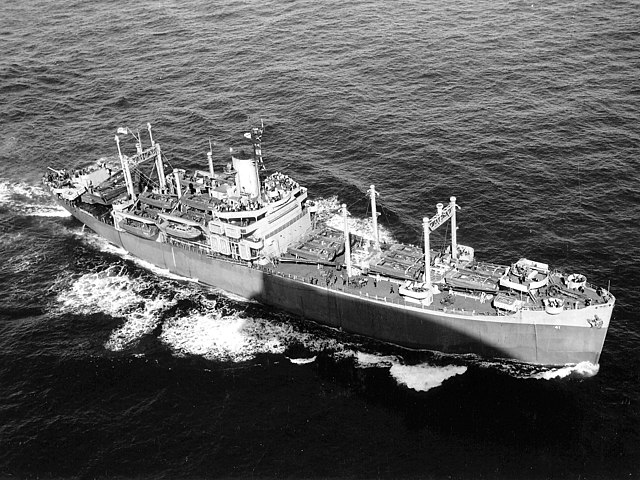
USS DuPage APA-41, 13 Oct. 1943
Actually the first large standard of assault transports based on the C3. Numbers varied from 28 to 34: USS Bayfield, Bolivar, Callaway, Cambria, Cavalier, Chilton, Clay, Custer, Du page, Elmore, Fayette, Fremont, Henrico, Knox, Lamar, Alpine, Barnstable, Burley, cecil, Dade, Medocino, montour, Riverside, Westmoreland, Hansford, Goodhue, Goshen, Grafton, or APA-33-48, 92, 93, 95, 96, 99-102, 104, 106-109. They were well armed thanks to a massive island with passengers accomodations. They were armed with two single 5-in 38, four twin 40 mm Bofors and 12 single 20 mm AA.
The two cargo holds amidships were converted into accommodation facilities with prefabricated floors and walls with three decks each devided into five high bunks beds and passageways, 30-in wide. Troops had their their own galley and mess hall separated from the Navy crew. They also had a sick bay and dental clinic. Concrete was used as ballast at the bottom of the holds for stability.
Single propeller but steam geared turbine coupled to more powerful boilers, allowing them to reach 17-18 knots for some time, to evade a surfaced U-Boat, at about 17.7 knots for the Type VII. Their real force resided in their payload, in general 12 LCVPs, four LCM and three LCP(L) plus a 4,500–4,800 tons cargo. The crew was quite extensive for a “civilian” freighter, with 51 officers and 524 sailors due to all their armament and additional facilities, while carrying some 80 officers and 1,146 privates.
Klondike-class destroyer tenders (APD)

USS Klondike (AD-22) at ancho August 1945
These four vessels were all built in Todd, San Pedro Cal.: USS Klondike (AD-22) (launched 30 July 1945, comp. 15 December 1970) as AR-22, USS Arcadia (AD-23) comm. 13 September 1945, USS Everglades (AD-24), comm. 25 May 1951 and USS Frontier (AD-25) and comm. 2 March 1946. They were sold for BU in 1974 but 1991 for USS Everglades.
Displacing 8,165 long tons (8,296 t)/11,755 long tons FL for 492 x 69 x 27 ft 3 in they were powered by the same C3 Geared turbines delivering 8,500 shp (6,338 kW) for 18.4 knots. They were well armed, with a single 5 in/38, four 3 in/23, four 40 mm AA and twenty 20 mm guns.
Also based on the same hull were the next Shenandoah-class (9 ships, commissioned 1945 or after the war) and Hamul class (AD-20). Like the former they saw little service in WW2, arriving too late.
Euryale/Aegir class submarine tenders (AS)
There was the USS Euryale, sole of her class (Displacement: 13,830 tons FL, 492’6″ x 69’6″ x 23’2″ 8,500 shp and 16.5 knots). Built at Federal-Kearny as a modified C3 type and comm. as AS-22 in 1943. There were also the following Aegir Class based on the C3-S-A2 type and comprising AS-23 USS Aegir, AS-24 USS Anthedon, AS-25 USS Apollo and AS-26 USS Clytie (Displacement 16,000 tons FL, 492′ x 69’6″ x 28’6″, 8,500 shp and 16.5 knots also with turbine engines). They were built in Federal-Kearny and commissioned in 1944, 1945 for the last one.
Chandeleur class seaplane tenders (AV)
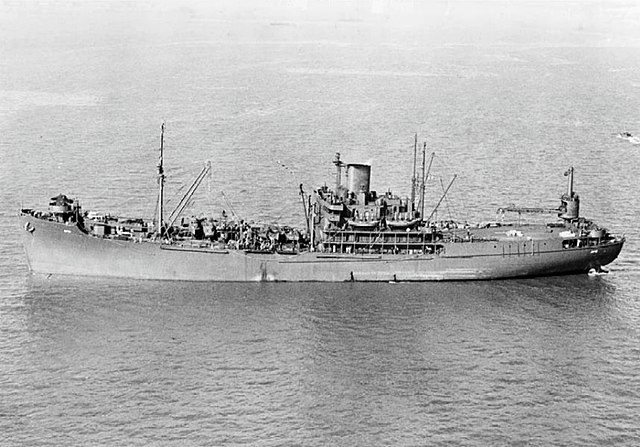
USS Chandeleur, AV-10
The lead ship was launched on 29 November 1941 and completed on 19 November 1942 in this role. She was pusrpose-built by the commission for this role, sole of the C3-S1-B1 type within its own shipbuilding program.
She was built by Western Pipe and Steel Company and earned 5 battle stars in the pacific. She had a large crane on her stern to fish aircraft from the sea and also a large aft desk space to repair aircraft. A successful type, many later C3 were converted on this standard. One of her seaplanes spotted IJN Yamato.
⚙ C3 class specifications |
|
| Dimensions | 492 ft (150 m) x 69.5 ft (21.2 m) x 28.5 ft (8.7 m) |
| Displacement | 7,800 gross tons, 12,000 deadweight tons. |
| Crew | Varying: Ex. 129 for USS Hercules |
| Propulsion | Installed power turbine developing 8,500 hp |
| Speed | 16.5 knots (30.6 km/h; 19.0 mph) (designed) |
| Range | Varying among ships, avg. 11,000 nm at 12 kts; |
| Armament | USS Hercules: 5 in/38 (127 mm) DP, 4x 3 in (76 mm) DP guns. |
Wartime use
The C3 cargos were put into their transport tasks as soon as available, and lessons learned from the design, perhaps too complex and costly led to the Liberty Ship standard, cheaper and much simplified. Still, the C3 rendered amazing service to Atlantic convoys, with their main davantage being their speed. In many occasions, captain spotting U-Boats were racing out of the formation to escape attacks. Unfortunately, Convoys rarely comprised only C3 cargos, and in that case, due to their range, they could not have sped up to max speed all along their trip, but perhaps the infamous “black hole” uncovered by smaller escort vessels and aviation in the middle of the Atlantic. C3 were mixed with every other cargo available, and had to comply to the slowest demonimator, to the captain’s frustration.
Other than that, turbines also had their dowside, and their were known gas-guzzlers. Although their range was enough to cross the Atlantic, high speed runs in case of attacks could jeopardize their ability to reach the desired range.
Theere were many losses, like Express (C3-E) torpedoed and sank off the coast of Madagascar on 30 June 1942, Almeria Lykes (C3) later Empire Condor, torpedoed and sank off Tunisia on 13 August 1942, Rio Hudson (C3-P&C)sunk as HMS Avenger off Gibraltar on 15 November 1942, a C3-S-A1 converted as USS Block Island (USN CVE-21) torpedoed and sank near the Azores and Canary Islands on 29 May 1944, Rio de Janeiro (C3-P&C) now the Avenger-class HMS Dasher sunk in the Lower Clyde in Scotland 1943 due to an accidental explosion, or USNS Card, sunk on 2 May 1964 in Saigon by the North Vietnamese frogman Lam Son Nao like the WW2 Italoan frogmen of old. Some vessels had an extensive carrer with the USN as cargoes and were awarded multiple times:
USS Hercules (AK-41)
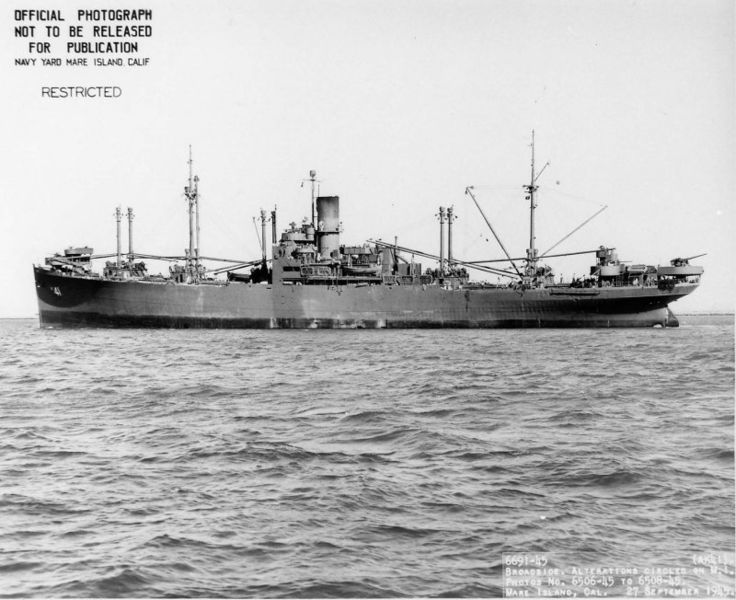
USS Hercules, AK-41
AK-41 was responsible for delivering goods and equipment to ships and stations in a war zone and was the ex-SS Exporter launched 18 July 1939 by Fore River Shipbuilding Co. in Massachusetts. She was ordered originally bt American Export Lines Inc. She was acquired by the Navy 15 July 1941 and kept her civilian crews until 30 November 1942 before commission at San Francisco under command of W. H. Turnquist. Her career is typical of WW2 USN-operated C3 cargos:
After reaching Noumea, New Caledonia, on 6 January 1943 to discharge her cargo she was back to San Francisco on 20 February and made a second run from 11 March to 5 July. She was in Pearl Harbor 6 August and became flagship, Admiral Willis A. Lee, CTF 11, while off Baker Island during the Army occupation. She made a crossing next to Pearl Harbor and then to San Francisco. On 13 October she was discharging her cargo to Funafuti, Ellice Islands and on 14 November at Pearl Harbor. After other trips she was in Pearl on 28 January 1944 for maintenance.
Next, she made two round-trips with cargo and passengers to San Francisco and in June, sailed with the Saipan invasion force, and from D-Day, discharging cargo, until the 24th. She was attacked several times by IJN aviation but was never hit. After a run back to Pearl Harbor she transport troops and cargo to Guadalcanal and sailing from there on 8 September to take part in the invasion of Peleliu in the Palau Islands. Next she carried goods to Hollandia, New Guinea and by mid-October was taking part in the Philippines invasion. She made several trips there until the invasion of San Pedro Bay 20 October and Lingayen Gulf landings on 9 January 1945.
Back in Ulithi 24 January 1945 she carried troops and cargo to Iwo Jima. She was hold in the retirement area until 27 February, disembarking reserve troops on the beach and received wounded soldiers. From 20 March she departed with many U.S. Marines and their equipment aboard for Pearl Harbor. Next she haded for Guam and Eniwetok and was back in San Francisco 22 June 1945 for her major overhaul. The war ended but she returned to the Pacific on 24 October 1945, loading ammunition in the Philippines and Admiralty Islands to reach Norfolk in Virginia on 26 March via Panama. She was decommissioned on 28 June 1946, transferred back to the Maritime Commission 18 July for merchant service as SS Exermont and SS Bostonian. She was scrapped in 1971, a common date for these C3s. For her Pacific wartime service she earned 5 battle stars.
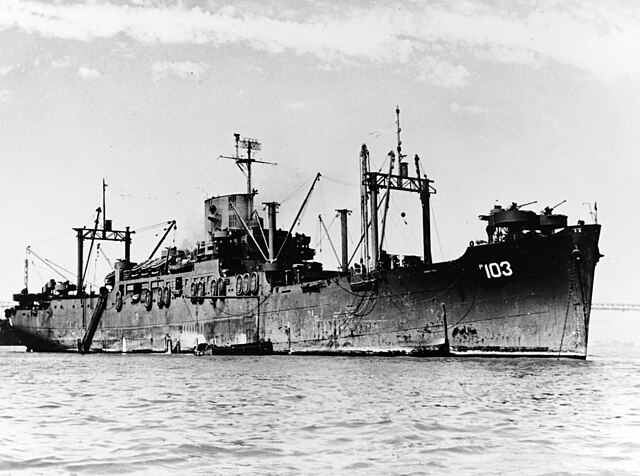
USS Hercules, AK-41
She was President Jackson-class attack transport, converted from a MCV Hull Type C3-P&C, MCV Hull No. 110. She started her career as SS President Polk (1941 – 4 October 1943) with a civilian crew, then was requisitioned by the Navy as a transport, and started her service commissioned as USS President Polk AP-103 from 4 October 1943 – 26 January 1946, earning 6 battle stars for her service.
As an attack transport she was far better armed as converted in 1943, than other C3 cargos acting as simple transport (AK): She had a more extensive crew of 354, parft of which manned her single 5″/38 caliber gun forward, four 3″/50 caliber dual-purpose gun mounts and four Bofors 40mm gun mounts. Launched 28 June 1941, she was acquired by the War Shipping Administration (WSA) on 5 December 1941, American President Lines operating as agent. She started her semi-civilian service in the Pacific, making particularly critical delivery to Hawaii on 19 December 1941 with a tanker and two freighters, in Brisbane in Australia (12 January 1942), 55 P-40E and 4 C-53 aircraft and their pilots plus 20 million of .30 caliber, 447,000 of .50 caliber, and 30,000 three-inch AA and 5,000 75 mm rounds of ammunition plus carloads of torpedoes and 615,000 pounds of rations, 178 officers and men to continue the war from Australia. Back, she transited via Townsville and Soerabaja with again, ammunition, bombs, airplanes, and rations for the KNIL.
She would also carry the 7th Naval Construction Battalion (7 officers, 433 enlisted men) from Samoa to Espiritu Santo in the New Hebrides in August. Her acquisition on 6 September 1943 and conversion by the Navy as assault transport meant she was transferred to the Naval Transportation Service, carrying her first battalion from Port Hueneme, California to Pearl Harbor by late 1943. She took part in the invasion of Tarawa, and stayed there to receive casualties, being back to Pearl Harbor 11 December. Next she operated at Kwajalein and became again an emergency hospital ship back to San Francisco. She also ferried troops to New Caledonia and Admiralty Islands.
In July 1944 she carried reinforcements to Guam and later to New Guinea. She was sent to Bougainville Island before the invasion of Luzon and disembarked troops at Lingayen beaches on 11 January 1945. She latter carried from Leyte, and was in Ulithi, taking Marines at Iwo Jima to Hawaii. After a stay in San Francisco she carried fresh troops to Okinawa on 24 July. After the war she was in Apra Harbor, Guam before proceeding back to San Francisco. She carried troops from Seattle to Tinian and took part in Operation Magic Carpet from October 1945, to and from Espiritu Santo and Manila. Decommissioned, she was transferred back to the War Shipping Administration , struck from the USN 25 February 1946 and continue her civilian service until 15 July 1965, sold to Ganaderos del Mar as “Gaucho Martin Fierro” anbd later “Minotauros”, then scrapped in 1970 in Taiwan.
USS Euryale (AS-22))

USS Euryale at Sasebo in November 1945 with I-401, I-14 and I-400 just surrendered nearby.
USS Euryale was originally the civilian “SS Hawaiian Merchant” ordered to Federal Shipbuilding and Drydock Company, Kearny, New Jersey, by the Matson Navigation Company, launched 12 April 1941 and completed by April 1941. She was to serve alongside Hawaiian Planter and Hawaiian Shipper but under the USA Transportation Corps charter, and then War Shipping Administration, until purchased on 15 April 1943 by the USN, recommissioned on 2 December 1943 as the submarine tender USS Euryale (AS-22).
After reaching Brisbane in Australia she headed for NYC on March 1944, loading provisions and supplies for Milne Bay in New Guinea. Until 26 May she refitted submarines and repaired surface ships as well. She was seen at Manus in May-August, staying anchired as a forward base and rest camp for submariners. her personal and equipment helped clearing the island and constructing buildings. She helped refitting 26 submarines, and was back to Brisbane on 16 August 1944 to load cargo to Fremantle.
She tended US submarines in Fremantle until 11 April 1945, then at Pearl Harbor until 16 August 1945 and on the 28th sailed to Guam as submarine base/rest camp. On 16 September she was in Okinawa, and later at Sasebo to work with Japanese submarines for disposal. She sailed then to Pearl Harbor with two Japanese submarines, one towed and proceeded to San Francisco (22 February) to be decommissioned on 7 October 1946. Unlike other C32 vessels she did not returned to civilian service but stayed in fleet reserve until 9 August 1972, whe she wass delivered back to the Maritime Administration at Bremerton, purchased by American Ship Dismantler for scrappng. During her service she was typically armed with a single 5 in/38 and four 3 in (76 mm) DP guns.
Post-ww2 service

A postwar C3 model, the Var

A postwar C3, the Loulea cutout
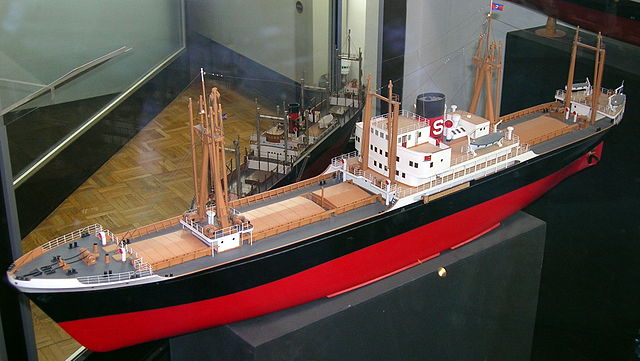
A postwar C3 with an extensive carrer: M/V Rose Schiaffino
Most C3 cargos not modified extensively for specialized roles returned promptly to civilian service, and for some were still around in 1980s “in their juice” after a few overhauls. But it was rare to reach that age. Most were scrapped in the 1970s. Other however were modernized extensively in the 1950s or 1960s and saw extensive service until the 1990s for some. However at the time, container ships were really the bulk of cargo transport, but not all harbours on the planet could accept these. Like most bulk carriers, these C3s still operated on these smaller harbours around the planet.
Sime of these vessels were designed as mixed cargos, like the six of Mississippi Shipping Co. built in Bethlehem Steel Co. started in December 1938 and completed in late 1940. A private design they served between Gulf ports and the East coast of South America with extensive Passenger accommodation for 67 in 26 staterooms on the shelter deck and two other complete decks. Later acquired by the USN so serve as AP and APA’s.
Some had amazing carrers, such as SS Barnes converted as CVE 7, then HMS Attacker (D 02), sold 1950 and rebuilt as the passenger ship “Castel Forte”, later “Fairsky”, then “Philippine Tourist” and scrapped in 1980. But the rcord goes to Cadmus (a C3 Modified, delivered on 23-Apr-46 to the USN as AR 14, and later resold to Taiwan in 1974 as Yu Tai (AR 521) and eventually scrapped in 1995, or St. George also a C3 Mod. from Tacoma, deliovered on 24 July 1944 and used by the USN as AV 16 and resold to Italy 1968 in service with the Marina Militare as Andria Bafile (A 5314), and also scrapped in 1995. Unfortunately, no C3 has been preserved to this day, unlike the Liberty and Victory ships. Unlike the first two, they were far less standardized and mass-built, making less understandable for the general public, and less desirable as museum ships. They not even survived indirectly through some CVE, unlike USS lunga Point, a Casablanca class.
Gallery
So, all in all, between the 238 vessels completed as C3 cargos, far more hulls were converted: 45 Bogue-class escort carriers, 59 Attack transports (3 Arthur Middleton class, 4 Crescent City class, 2 Frederick Funston class, 9 Windsor class, 34 Bayfield class and 7 President Jackson class), 7 Submarine tenders (Euryale, 2 Griffin-class, 4 Aegir-class), 2 Delta-class repair ships (AR-9, AR-12) and 2 Amphion-class repair ships, so 115 extra C3 hulls for conversions, so 353 total.
USS Euryale (AS-22) 21 August 1944
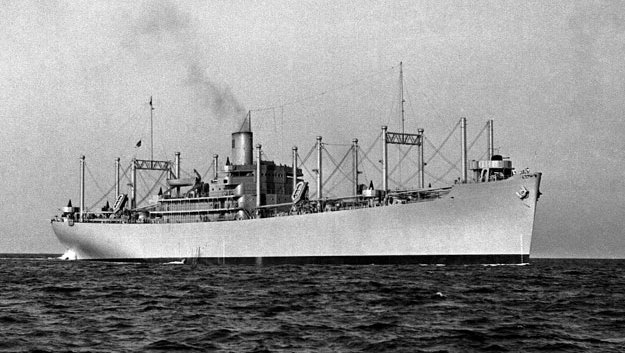
USS Sea Tarpon in construction at Ingalls. She was a C3-S-A2 type.
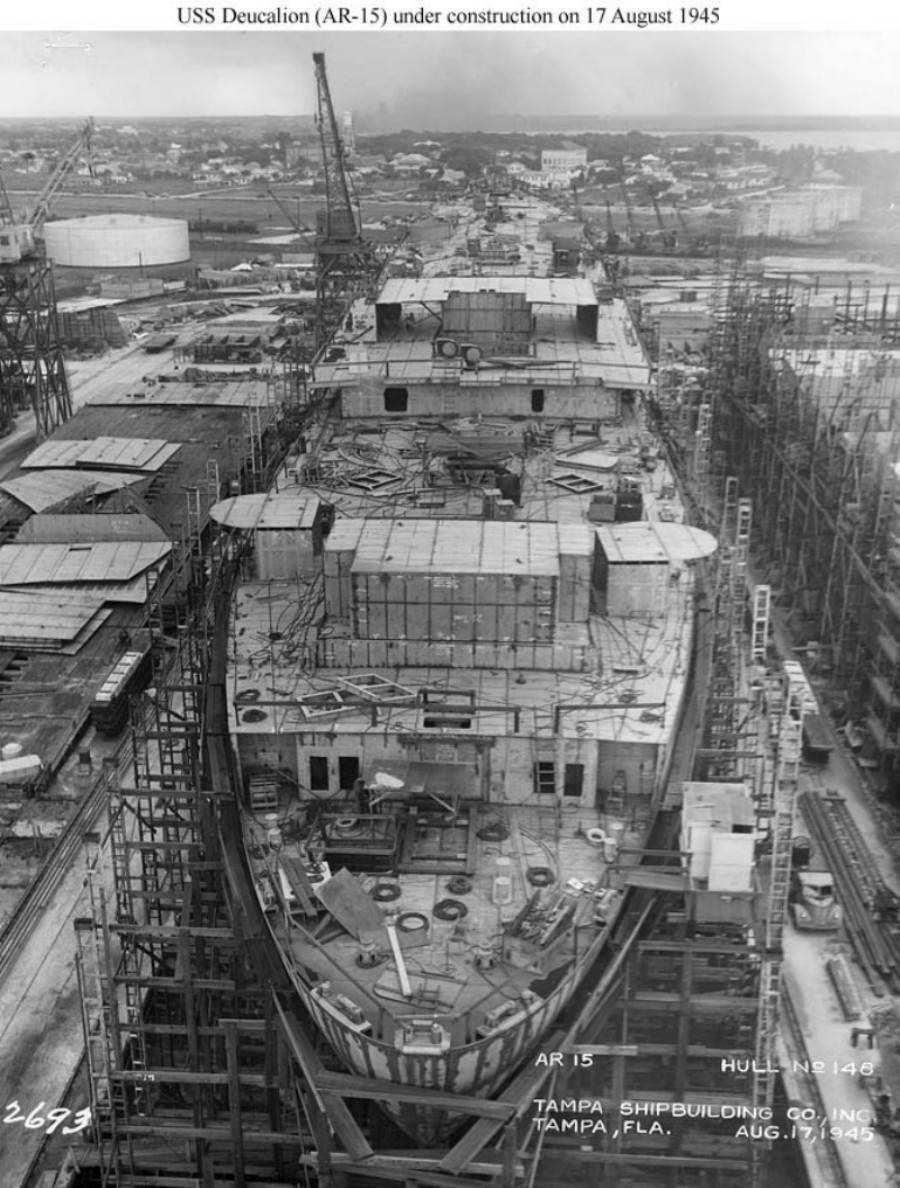
USS Deucalion (AR-15) remair ship
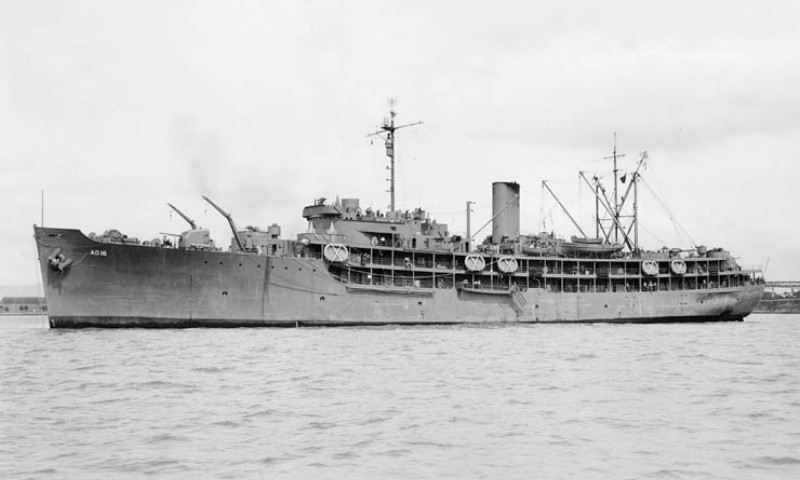
USS Cascade AD-16, destroyer supply ship
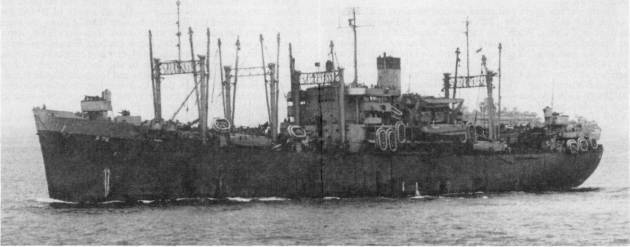
USS Anne Arundel
Links and sources

A stranded C3, Dominator, tossed over the reefs in 1961, from Life magazine.
Books
Sawyer, L.A.; Mitchell, W.H. (1981). From America to United States: The History of the Long-range Merchant Shipbuilding Programme of the United States Maritime Commission. London: World Ship Society.
Links
On usmaritimecommission.de
Full list on shipbuildinghistory.com, 162 built in five variants and 75 to other designs by size group.
C3 bases sub tenders
usmm.org full list of C3 vessels
ss-african-mercury shipsnostalgia.com
Mormacisle on shipspotting
about thge C3 based USN Comet, first Ro-Ro (1957)
USS Chandeleur on maritime.dot.gov
May 1941 review of Hawaiian Merchant/Skipper
Matson navigation vessels
Videos
3D models
Model kits
Revell’s Merchant fleet kit, C3 freighter and T3 tanker
1947 Beavercove (499′ Long) On nscaleships.com
modelwarships.com review
RC model


 Latest Facebook Entry -
Latest Facebook Entry -  X(Tweeter) Naval Encyclopedia's deck archive
X(Tweeter) Naval Encyclopedia's deck archive Instagram (@navalencyc)
Instagram (@navalencyc)





 French Navy
French Navy Royal Navy
Royal Navy Russian Navy
Russian Navy Armada Espanola
Armada Espanola Austrian Navy
Austrian Navy K.u.K. Kriegsmarine
K.u.K. Kriegsmarine Dansk Marine
Dansk Marine Nautiko Hellenon
Nautiko Hellenon Koninklije Marine 1870
Koninklije Marine 1870 Marinha do Brasil
Marinha do Brasil Osmanlı Donanması
Osmanlı Donanması Marina Do Peru
Marina Do Peru Marinha do Portugal
Marinha do Portugal Regia Marina 1870
Regia Marina 1870 Nihhon Kaigun 1870
Nihhon Kaigun 1870 Preußische Marine 1870
Preußische Marine 1870 Russkiy Flot 1870
Russkiy Flot 1870 Svenska marinen
Svenska marinen Søværnet
Søværnet Union Navy
Union Navy Confederate Navy
Confederate Navy Armada de Argentina
Armada de Argentina Imperial Chinese Navy
Imperial Chinese Navy Marinha do Portugal
Marinha do Portugal Mexico
Mexico Kaiserliche Marine
Kaiserliche Marine 1898 US Navy
1898 US Navy Sovietskiy Flot
Sovietskiy Flot Royal Canadian Navy
Royal Canadian Navy Royal Australian Navy
Royal Australian Navy RNZN Fleet
RNZN Fleet Chinese Navy 1937
Chinese Navy 1937 Kriegsmarine
Kriegsmarine Chilean Navy
Chilean Navy Danish Navy
Danish Navy Finnish Navy
Finnish Navy Hellenic Navy
Hellenic Navy Polish Navy
Polish Navy Romanian Navy
Romanian Navy Turkish Navy
Turkish Navy Royal Yugoslav Navy
Royal Yugoslav Navy Royal Thai Navy
Royal Thai Navy Minor Navies
Minor Navies Albania
Albania Austria
Austria Belgium
Belgium Columbia
Columbia Costa Rica
Costa Rica Cuba
Cuba Czechoslovakia
Czechoslovakia Dominican Republic
Dominican Republic Haiti
Haiti Hungary
Hungary Honduras
Honduras Estonia
Estonia Iceland
Iceland Eire
Eire Equador
Equador Iran
Iran Iraq
Iraq Latvia
Latvia Liberia
Liberia Lithuania
Lithuania Mandchukuo
Mandchukuo Morocco
Morocco Nicaragua
Nicaragua Persia
Persia San Salvador
San Salvador Sarawak
Sarawak Uruguay
Uruguay Venezuela
Venezuela Zanzibar
Zanzibar Warsaw Pact Navies
Warsaw Pact Navies Bulgaria
Bulgaria Hungary
Hungary

 Bundesmarine
Bundesmarine Dutch Navy
Dutch Navy Hellenic Navy
Hellenic Navy Marina Militare
Marina Militare Yugoslav Navy
Yugoslav Navy Chinese Navy
Chinese Navy Indian Navy
Indian Navy Indonesian Navy
Indonesian Navy JMSDF
JMSDF North Korean Navy
North Korean Navy Pakistani Navy
Pakistani Navy Philippines Navy
Philippines Navy ROKN
ROKN Rep. of Singapore Navy
Rep. of Singapore Navy Taiwanese Navy
Taiwanese Navy IDF Navy
IDF Navy Saudi Navy
Saudi Navy Royal New Zealand Navy
Royal New Zealand Navy Egyptian Navy
Egyptian Navy South African Navy
South African Navy






























 Ukrainian Navy
Ukrainian Navy dbodesign
dbodesign